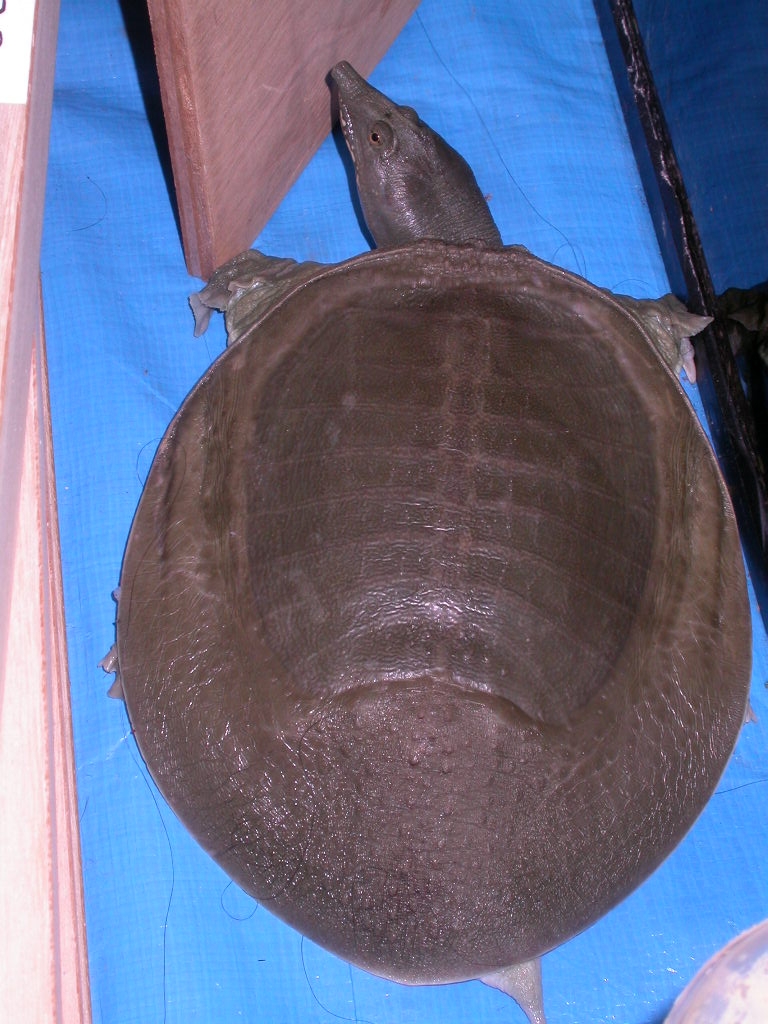- Trionychidae
Taxobox
name = Trionychidae

image_caption = Chinese Softshelled Turtle
"Pelodiscus sinensis "
regnum =Animal ia
phylum = Chordata
classis = Reptilia
subclassis =Anapsida
ordo =Testudines
subordo =Cryptodira
superfamilia =Trionychoidea
familia = Trionychidae
familia_authority = Fitzinger, 1826
subdivision_ranks = Subfamilies
subdivision =Cyclanorbinae Trionychinae Trionychidae is a taxonomic family which comprises a number of
turtle genera commonly known as soft-shell turtles. It consists of some of the world's largestfresh water turtles, though many can adapt to living in highlybrackish areas. Members of this family occur inAfrica ,Asia ,North America , and theEast Indies . North American members of genus "Trionyx " were fairly recentlywhen assigned the new genus name "Apalone ", though they are still listed semi-correctly as "Trionyx" in some texts.Characteristics
They are called "soft shelled" because their
carapace lacks hornyscute s (scales), though the Spiny Softshell Turtle, "Apalone spinifera ", does have some scale-like projections, hence its name. The carapace is leathery and pliable, particularly at the sides. The central part of the carapace has a layer of solid bone beneath it, as in other turtles, but this is absent at the outer edges. Some species also have dermal bones in theplastron , but these are not attached to the bones of the shell. The light and flexible shell of these turtles allows them to move more easily in open water, or in muddy lake bottomscite book |editor=Cogger, H.G. & Zweifel, R.G.|author= Obst, Fritz Jurgen|year=1998|title=Encyclopedia of Reptiles and Amphibians|publisher= Academic Press|location=San Diego|pages= 117-118|isbn= 0-12-178560-2] .Females can grow up to several feet in carapace diameter, while males stay much smaller; this is their main form of
sexual dimorphism . "Pelochelys cantorii ", found in southeastern Asia, is the largest softshell turtle on earth.-like nostrils. Their necks are disproportionately long in comparison to their body size, enabling them to breathe surface air while their bodies remain submerged in the substrate (mud or sand) a foot or more below the surface.
Like some
amphibian s and marine snakes, softshell turtles are able to extract a small amount of oxygen out of water via their skin, further enabling them to stay underwater for prolonged periods. [King, Peter and Harold Heatwole (1994) Partitioning of Aquatic Oxygen Uptake among Different Respiratory Surfaces in a Freely Diving Pleurodiran Turtle, "Elseya latisternum". Copeia, 3:802-806] Their feet are webbed and are three-clawed, hence the "Tri"-" in the genus name. The carapace color of each type of softshell turtle tends to match the sand and/or mud color of its geographical region, assisting in their "lie and wait" feeding methodology.Soft-Shelled Turtles look rather helpless but are fully able to protect them-selves in time of danger. "Hidden by the lips, are a pair of mandibles remarkably keen and strong; on many specimens the mandibles form the outer border of powerful crushing processes- the alveolar surfaces of the jaws; examples thus provided feed largely on mollusks. Taken at a disadvantage, out of the water, the soft-shelled turtles are savage fighters. the head darts at an offending object like that of a snake. Large turtles are dangerous; for they can amputate a man's finger- possibly his hand." [Ditmars]
Soft shell turtles are eaten as a delicacy in most parts of their range, particularly in East Asia.
Taxonomy
Family Trionychidae
*"Palaeotrionyx " (extinct)
*SubfamilyCyclanorbinae
**Genus "Cyclanorbis "
**Genus "Cycloderma "
**Genus "Lissemys "
*SubfamilyTrionychinae
**Genus "Amyda "
**Genus "Apalone "
**Genus "Aspideretes "
**Genus "Chitra"
**Genus "Dogania "
**Genus "Nilssonia"
**Genus "Palea "
**Genus "Pelochelys "
**Genus "Pelodiscus "
**Genus "Rafetus "
**Genus "Trionyx "Notes
References
* [http://www.tigr.org/reptiles/families/Trionychidae.html The Reptile Database: Family Trionychidae]
Parade of the Animal Kingdom. Hegner, Robert. 1935. the Macmillan Company.
Wikimedia Foundation. 2010.
